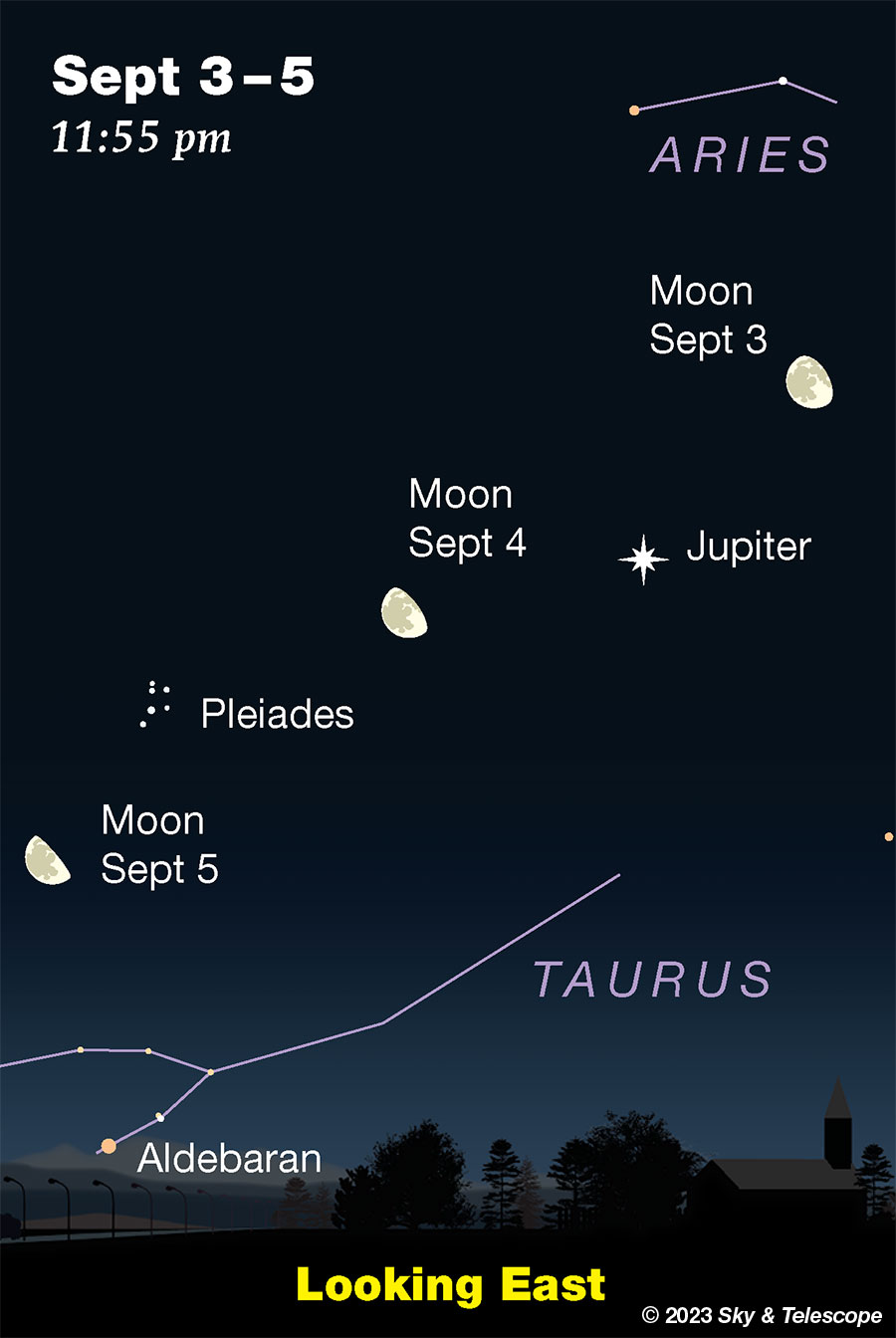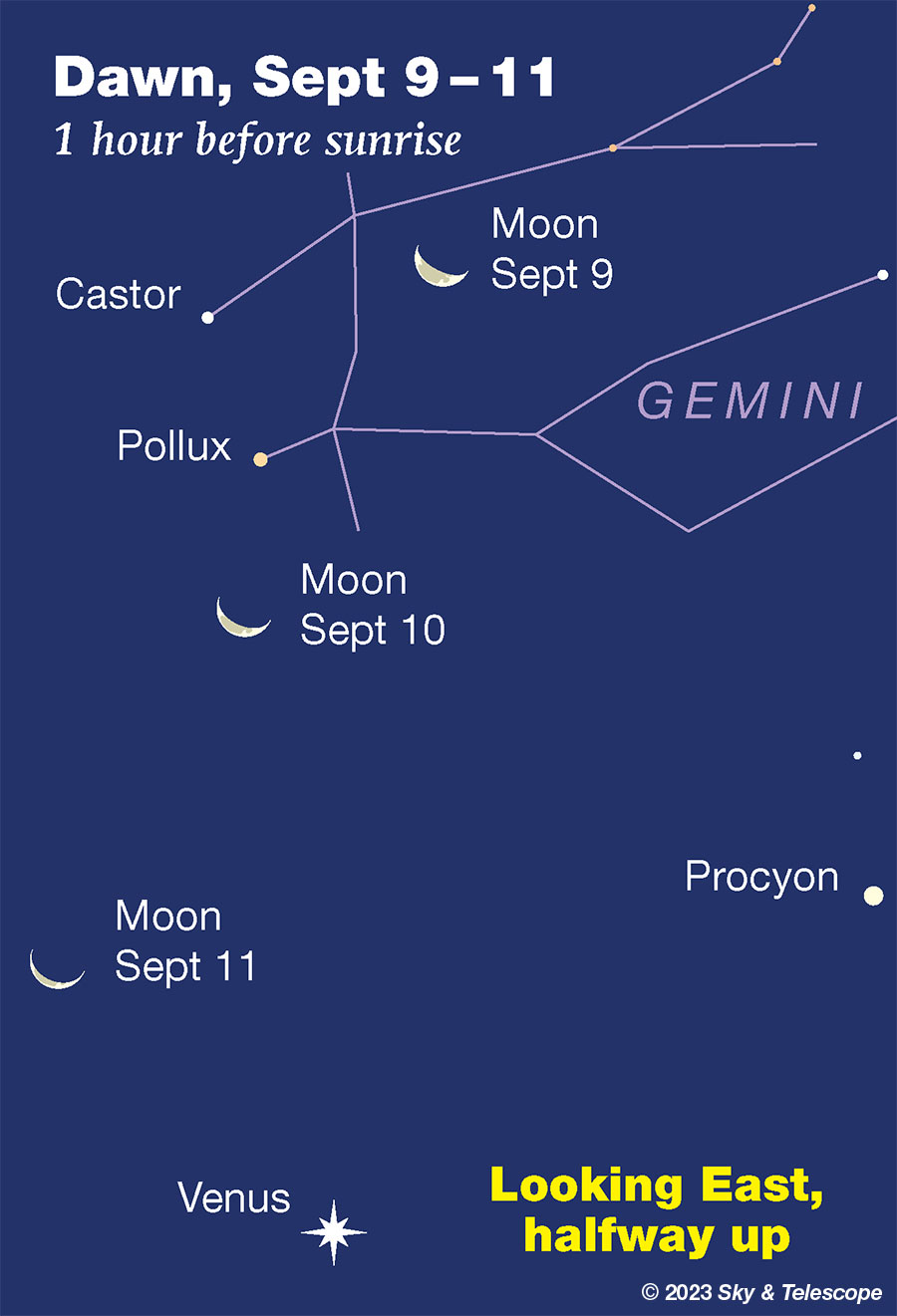SATURDAY, SEPTEMBER 2
¦ The two brightest stars of September evenings are Vega high overhead and Arcturus in the west, both magnitude 0.
Draw a line from Vega down to Arcturus. A third of the way down you cross the dim Keystone of Hercules. Two thirds of the way you cross the dim semicircle of Corona Borealis displaying its one modestly bright star: Alphecca, the gem of the crown.
SUNDAY, SEPTEMBER 3
¦ A late-night telescope session tonight offers the Moon in its interesting waning gibbous phase. Lunar landforms near the terminator cast their shadows in the opposite direction from when you see the Moon as a thick waxing crescent in early evening.
Then switch to Jupiter shining right nearby, as shown below. Jupiter's four bright Galilean moons are roughly the size of our own Moon, but at 1,800 times the distance, they appear in a telescope as hardly more than pinpoints.
Jupiter's Great Red Spot should transit the planet's central meridian tonight around 1 a.m. EDT.
 As the waning Moon nears last quarter it rises later and later in the night, passing Jupiter and then the Pleiades on the way.MONDAY, SEPTEMBER 4 As the waning Moon nears last quarter it rises later and later in the night, passing Jupiter and then the Pleiades on the way.MONDAY, SEPTEMBER 4
¦ The waning gibbous Moon rises around 10 p.m. with Jupiter 6° or 7° to its right. They cross the sky together for the rest of the night.
TUESDAY, SEPTEMBER 5
¦ As dusk turns to night, Arcturus twinkles due west. It's getting lower every week. Off to its right in the northwest, the Big Dipper is swinging down on its way to turning level.
WEDNESDAY, SEPTEMBER 6
¦ Vega now passes the zenith right around the end of twilight, for those of us at mid-northern latitudes. Vega is bigger, hotter, and 50 times brighter than our Sun. But at a distance of 25 light-years, it's 1.6 million times farther away. We're lucky that our eyes can see such things at all. As they evolved, they had no need to.
¦ Last-quarter Moon (exactly so at 6:21 p.m. EDT). It rises around 11 or midnight tonight, in eastern Taurus.
Once it's well up, look for El Nath (Beta Tauri) about 5° to its left or lower left. Brighter Aldebaran is some 10° to the Moon's right.
THURSDAY, SEPTEMBER 7
¦ In the barren region midway between the handle of the Sagittarius Teapot and the bottom of boat-shaped Capricornus lies an asterism of four stars all by itself. In ancient times Ptolemy cataloged it as the Tetrapleuron, the Quadrilateral. Being so isolated, it was not incorporated into the star pattern of either constellation. Nowadays the group is sometimes known as The Dogs (from a local tradition in southern China of monsterous dog-people in the mountains) or, more recently, as Herman's Cross, named for the late Maryland amateur astronomer Herman Heyn who rediscovered it and publicized it.
Herman's Cross is now highest on the meridian in mid-evening. It lies more or less on its side and is about 1° by 2° in size. Its stars are all about magnitude 4½, making it a fine binocular target and visible to the naked eye in a moderately dark sky. It's such a distinctive little thing that once you know it you'll spot it often in photos of the Sagittarius Milky Way, demurely off to the east of the main attraction.
Two telescopic globular clusters, M75 and M55, lie a few degrees above and below it. They're 9th and 7th magnitude, respectively. See Matt Wedel's Binocular Highlights article and chart in the September Sky & Telescope, page 45.
FRIDAY, SEPTEMBER 8
¦ With September well under way, the Great Square of Pegasus is high in the east after dark, balancing on one corner.
From the Great Square's left corner extends a big line of three 2nd-magnitude stars, running to the lower left, that mark the head, backbone and leg of the constellation Andromeda. (The line of three includes the Square's corner, her head.) Upper left from the foot of this line, you'll find W-shaped Cassiopeia tilting up.
¦ By 9 or 10 p.m. two of the best-known deep-sky objects are in high view in the area: the Double Cluster in Perseus (just below Cassiopeia), and the Great Andromeda Galaxy, M31. Did you know they're only 22° apart?
They're both cataloged as 4th magnitude but to the naked eye they look rather different, the more so the darker your sky. See for yourself; they're plotted on the all-sky constellation map in the center of the September Sky & Telescope, which should be all the map you need to identify their locations. They're below Cassiopeia and farther to Cassiopeia's right, respectively. Sky too bright? Use binoculars!
The two clusters of the Double Cluster (NGC 869 and NGC 884) are at very similar distances about 7,600 light-years away. M31, at 2.5 million light-years, is about 330 times farther.
 In early dawn, the waning Moon passes Castor and Pollux above Venus. In early dawn, the waning Moon passes Castor and Pollux above Venus.
SATURDAY, SEPTEMBER 9
¦ The waning crescent Moon rises around 3 a.m. Sunday morning the 10th, under Castor and Pollux. By early dawn they're a vertical lineup high in the east as shown above.
SUNDAY, SEPTEMBER 10
¦ With the evening sky moonless, this is a great week for the Milky Way under a dark sky. When Deneb crosses your zenith (two hours after Vega does, meaning around 10 or 11 p.m.), the Milky Way does too — running straight up from your southwest horizon and straight down to your northeast horizon. |





 As the waning Moon nears last quarter it rises later and later in the night, passing Jupiter and then the Pleiades on the way.MONDAY, SEPTEMBER 4
As the waning Moon nears last quarter it rises later and later in the night, passing Jupiter and then the Pleiades on the way.MONDAY, SEPTEMBER 4 In early dawn, the waning Moon passes Castor and Pollux above Venus.
In early dawn, the waning Moon passes Castor and Pollux above Venus.